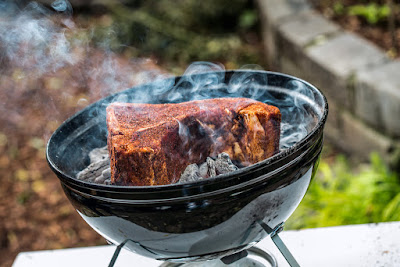For a Better Steak, Cook Directly on Charcoal - Hello! We’ve
never been the kind of guys to worship outdoor grilling gear and
technology. When we were growing up, Dad set the tone, making do with a
rusty hardware store hibachi and a metal chimney. We’ve written about
the ascetic thrill of using government-issue grills in state parks.
But
recently we picked up a trick from a Dallas chef that has rocked our
minimalist approach to its foundation: We cook meats directly on the
coals.
No,
the precious porterhouses do not incinerate, even though the heat is
consistently 800 to 1,000 degrees. The char is robust and earthy, but
never too ashy or excessive, even when we use thinner cuts like hanger
and skirt.
In
fact, the method promises to reduce anxiety at our outdoor parties this
summer by making the grilling speedier and more consistent, with far
less sooty flare-up than when we raise our steaks a few inches onto a
grate above the coals. (That air space between the meat and the heat
provides oxygen for combustion.)
This is especially advantageous with fatty chops like pork and lamb,
which turn out beautifully when you go commando and toss them directly
onto the glowing coals.
Thank Tim Byres, an evangelist for live-fire cooking in his Smoke restaurants, who demonstrated the technique in May for a segment of our new TV show, “Southern Uncovered,” on Ovation.
The
producers were secretly hoping for an Icarus moment, some kind of
spectacular calamity on the restaurant’s 10-foot-long open fire pit, but
the only pyrotechnics were in our brains; this simple act demolished
everything we thought we knew about cooking proteins.
Even
Mr. Byres’s richly marbled five-pound “Eisenhower steak” (a
Brobdingnagian rib-eye with short rib attached, about two feet long),
when cooked 10 minutes on each side, emerged with just a couple of
silver dollars’ width of char.
The
sugary, spicy dry rub he had patted into the beef before it hit the
fire caramelized into a nice crust with that crave-worthy wisp of smoky
bitterness that is the objective of outdoor cooking, and so welcome
against the sweet richness of luscious protein and browned fat.
He credits President Dwight D. Eisenhower, a native of Denison, Tex., with turning him on to this technique.
“I
heard a rumor of Ike grilling these really thick four-inch sirloins,”
said Mr. Byres, who tracked down a 1953 article in The Miami Daily News
that confirmed his hunch: Eisenhower, it said, “rubs the steak with oil
and garlic and then, as the horrified guests look on, casually flings
the steak into the midst of the red and glowing coals.”
Two
chimneys lighted simultaneously are ideal, and will provide enough
coals to cook several rounds of steaks, chops and foil-wrapped corn in
succession. (One chimney full is sufficient for a couple of rounds, for a
smaller group.)
In
our tests, a dry rub (any rub, though Mr. Byres’s coffee-spiked version
here is excellent) proved essential to protect the steak from the
charcoal. We detected a thin coating of grit on bare steaks.
Before
laying down the steak for the first time, give a good blow across the
bed of coals to disperse any ash. Fastidiousness has no place around the
live fire: A little wood ash is probably inevitable on your meat, but
it will be invisible and will not interfere with the flavor.
For
thinner three-quarter-inch steaks, cooking three to five minutes on
each side produces the desired char and a rare interior; that translates
to eight to ten minutes for the three- and four-inch steaks Mr. Byres
prefers. For medium- to medium-rare, continue cooking another three
minutes or so over indirect heat, up on the grate.
Source: NYTimes


0 comments:
Post a Comment